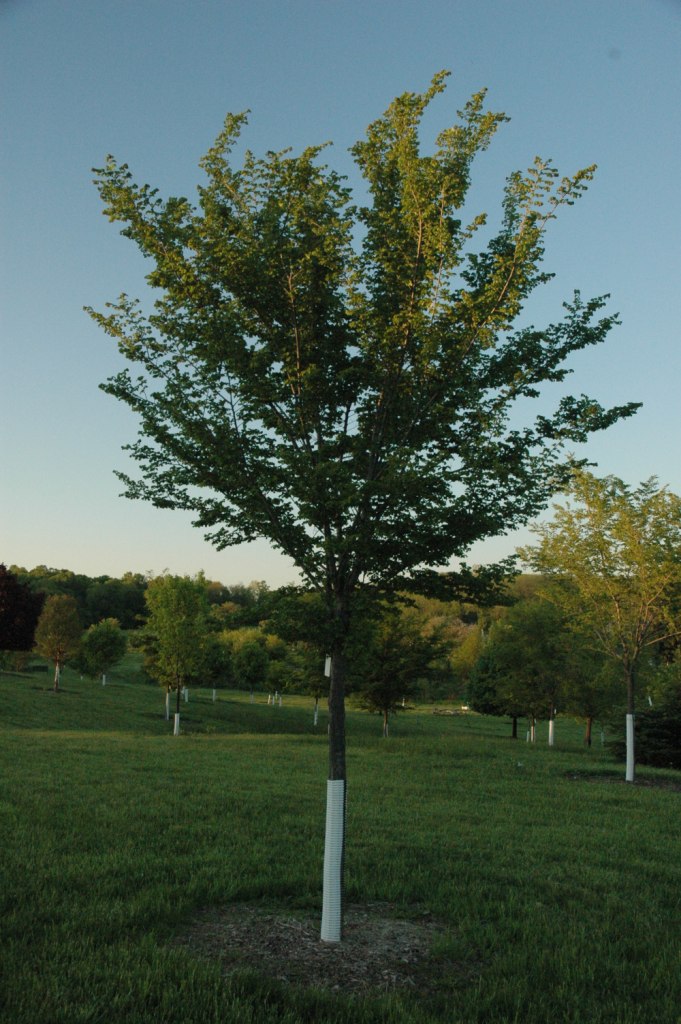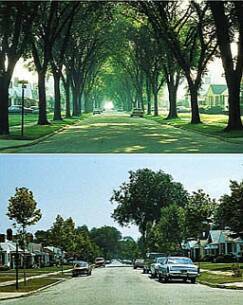While the Emerald Ash Borer (EAB) continues to expand in the upper Midwest (see http://www.emeraldashborer.info/files/MultiState_EABpos.pdf for a current infestation map), EAB is old news here in Michigan, especially in the southeastern part of the state. Efforts to restore urban and community forest canopy lost to EAB will continue, however, for the foreseeable future. In 2003 we established an Ash Alternative Arboretum MSU Tollgate Education Center in Novi, MI – which is near ‘Ground Zero’ for the EAB infestation in North America.
The planting offers some insights into selecting alternative landscape trees to replace ashes. A couple of elm cultivars, in particular, have emerged as shining stars in the demonstration planting that includes five specimens of 37 different species and varieties. All trees were planted as 1½”-2” bareroot liners by Tollgate volunteers. Tollgate farm manager Roy Prentice has overseen the maintenance of the planting.

Accolade elm (Ulmus japonica × wilsoniana ‘Morton’) Compared to most of the other selections planted in the arboretum at Tollgate, Accolade elm looks like a man among boys. Growth of these trees has been outstanding – the trunks of the trees have grown fast enough that they have split off their plastic rabbit guards (see photo). Like Triumph elm, Accolade elm has dark green glossy leaves and develops into a large tree. Although elms are often thought of ‘ugly ducklings’, both Triumph and Accolade are quickly developing well-formed vase-like crowns.

Triumph elm (Ulmus ‘Morton Glossy’) has also done very well at the Tollgate planting. This elm develops a vase-like crown with age and has dark green, glossy leaves. A large tree to 55’.
The elms are part of series of elm cultivars that have been developed with high tolerance of Dutch elm disease. Most of the new elms are hybrid crosses with Asian and European elm species, though selections of American elm that are tolerant of Dutch elm disease are also available in the nursery trade. The irony in all of this, of course, is that native American elms were devastated by another introduced exotic pest, Dutch elm disease. As elm trees were rapidly lost during the 1950’s, 60’s, and 70’s, ash trees became a popular replacement due to their ease of transplanting, growth rate, broad site tolerance and pest resistance (yet another irony). Now we’re promoting elms to replace ashes.

Street scene before and after Dutch Elm Disease. Photo: theprincetonelm.com
The moral of the Dutch Elm Disease and Emerald Ash Borer stories is that it’s critical to avoid over-reliance on one species or even one genus – even a native one. In Michigan some of our urban and community forests are over 50% maple. As global trade increases and the potential for destructive pests to hitch-hike around the world rises, the best hedge against catastrophic tree loss is to plant a broad and diverse array of adapted trees.
It’s great to hear about the AAA at Tollgate; now I know where to look for information on a wider variety of elm cultivars. I have planted some American elms here in MA, and w
hen I tagged my first three I was a bit stymied by what to look for. Dutch Elm Disease had so decimated the American Elm stock in New England that I wasn’t sure how to ‘read’ a juvenile elm’s structure, and worked my way back from my knowledge of elm’s mature structure and timber qualities. Elms certainly are ugly ducklings when they’re really young, but they grow and develop the vaselike habit pretty quickly. Thanks for this post, Bert!
We’re very lucky in Australia – we don’t have Dutch Elm Disease… yet. I read somewhere that Melbourne has some of the best examples of elm avenues left in the world thanks to DED. It’ll be devastating when it arrives here – and it will eventually.
We have planted just about every cultivar of elm out there in the Village I work for. The Accolade is one of my least favorite at this point due to its growth habit. If you go back to the tree in your photo in a couple years, the multiple leaders usually will have taken off to a point past where corrective pruning can be effective. We have had a hard time developing a straight single leader on the Accolade variety. I am hoping that as it gets older, it won’t be as noticable as it is now.
I hope I’m not off topic, but your before and after DED picture gave me a flashback. I was a little girl in Buffalo when they came and cut down all the street trees. There was a robin’s nest in our tree. The hatchlings died in spite of our best efforts. Our development wasn’t all that old, so the trees can’t have been as big as the ones in your photo. How hot the “after” picture looks.
We live in a global community now with it’s pro’s and cons. When the long horn beetle was found at a bonsai nursery here in the Seattle area, they cleared the entire hillside of all possible hosts.
Lines of the same trees running along the streets looks tidy and symmetrical, but monoculture of any kind is not a good idea. I’ll have to remind my husband of that next time he complains about me putting in too many different plants.
what are the bumps on the leaves that turn brown and look ugly ?
Cathy:
I assume you are talking about black spot on elm leaves. Like many leaf spot diseases of shade trees, this is caused by a fungal pathogen. Also, like most leaf spots, the damage is mostly aesthetic and doesn’t pose a serious issue for the tree. In most cases. leaf spots don’t warrant any corrective measures. It’s usually thought that disposing of the infected leaves when they drop in the fall with reduce re-infection but some pathologists will dispute this.
Here’s some more info.
http://web.aces.uiuc.edu/vista/pdf_pubs/648.pdf
Our street has been devastated by the EAB, it looks like the ‘after’ picture above. As a previous poster stated, it is indeed hot. The shade is gone and the grass that was so used to being constantly covered and cooled is quickly starting to die. Flowers and shrubs that were planted full or partial shade are also starting to die.